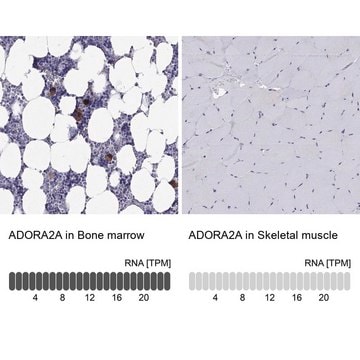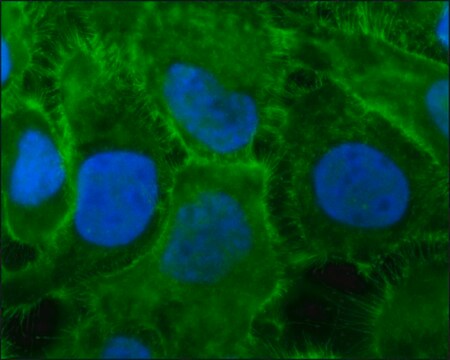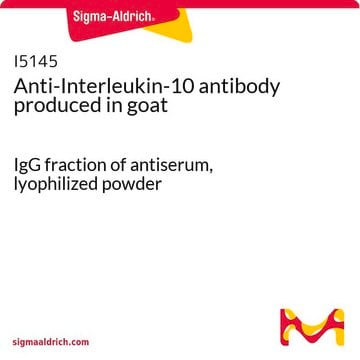HTS153RTA
Ready-to-Assay GPR68/OGR1 Proton-Sensing Receptor Frozen Cells
Human
Autenticatiper visualizzare i prezzi riservati alla tua organizzazione & contrattuali
About This Item
Codice UNSPSC:
41106514
eCl@ss:
32011203
NACRES:
NA.84
Prodotti consigliati
product name
Ready-to-Assay GPR68/OGR1 Proton-Sensing Receptor Frozen Cells, Human GPR68/OGR1 GPCR frozen cells for Calcium Flux FLIPR Assays.
Origine biologica
human
Livello qualitativo
Produttore/marchio commerciale
Ready-to-Assay
tecniche
calcium flux assay: suitable
N° accesso NCBI
Metodo di rivelazione
fluorometric
Condizioni di spedizione
dry ice
Descrizione generale
Millipore’s Ready-to-Assay GPCR frozen cells are designed for simple, rapid calcium assays with no requirement for intensive cell culturing. Millipore has optimized the freezing conditions to provide cells with high viability and functionality post-thaw. The user simply thaws the cells and resuspends them in media, dispenses cell suspension into assay plates and, following over night recovery, assays for calcium response.
GPR68, also known as OGR1 (ovarian cancer G-protein-coupled receptor 1), was initially thought to be a receptor for sphingosylphosphorylcholine, although these results are controversial. Subsequent studies indicated that GPR68/OGR1 functions as a Gq-coupled sensor for extracellular pH, with maximal signaling occurring at pH of 7 or below (Ludwig et al., 2003; Tomura et al., 2005). Expression of GPR68/OGR1 is upregulated during RANKL-induced osteoclast differentiation, and knockdown of GPR68/OGR1 expression inhibits this differentiation process (Yang et al., 2006). Millipore’s cloned human GPR68-expressing cell line is made in the Chem-1 host, which supports high levels of recombinant GPR68 expression on the cell surface and contains high levels of the promiscuous G protein G15 to enhance coupling of the receptor to the calcium signaling pathway. Thus, the cell line is an ideal tool for screening for antagonists of interactions between GPR68 and its ligands.
GPR68, also known as OGR1 (ovarian cancer G-protein-coupled receptor 1), was initially thought to be a receptor for sphingosylphosphorylcholine, although these results are controversial. Subsequent studies indicated that GPR68/OGR1 functions as a Gq-coupled sensor for extracellular pH, with maximal signaling occurring at pH of 7 or below (Ludwig et al., 2003; Tomura et al., 2005). Expression of GPR68/OGR1 is upregulated during RANKL-induced osteoclast differentiation, and knockdown of GPR68/OGR1 expression inhibits this differentiation process (Yang et al., 2006). Millipore’s cloned human GPR68-expressing cell line is made in the Chem-1 host, which supports high levels of recombinant GPR68 expression on the cell surface and contains high levels of the promiscuous G protein G15 to enhance coupling of the receptor to the calcium signaling pathway. Thus, the cell line is an ideal tool for screening for antagonists of interactions between GPR68 and its ligands.
Descrizione della linea cellulare
GPCR Cell Lines
Host cells: Chem-1
Azioni biochim/fisiol
GPCR Class: A
Protein Target: GPR68/OGR1
Target Sub-Family: SPC/LPC /proton-sensor
Componenti
Pack contains 2 vials of mycoplasma-free cells, 1 ml per vial.
Fifty (50) mL of Media Component.
Fifty (50) mL of Media Component.
Codice della classe di stoccaggio
10 - Combustible liquids
Classe di pericolosità dell'acqua (WGK)
WGK 1
Punto d’infiammabilità (°F)
Not applicable
Punto d’infiammabilità (°C)
Not applicable
Certificati d'analisi (COA)
Cerca il Certificati d'analisi (COA) digitando il numero di lotto/batch corrispondente. I numeri di lotto o di batch sono stampati sull'etichetta dei prodotti dopo la parola ‘Lotto’ o ‘Batch’.
Possiedi già questo prodotto?
I documenti relativi ai prodotti acquistati recentemente sono disponibili nell’Archivio dei documenti.
Il team dei nostri ricercatori vanta grande esperienza in tutte le aree della ricerca quali Life Science, scienza dei materiali, sintesi chimica, cromatografia, discipline analitiche, ecc..
Contatta l'Assistenza Tecnica.






